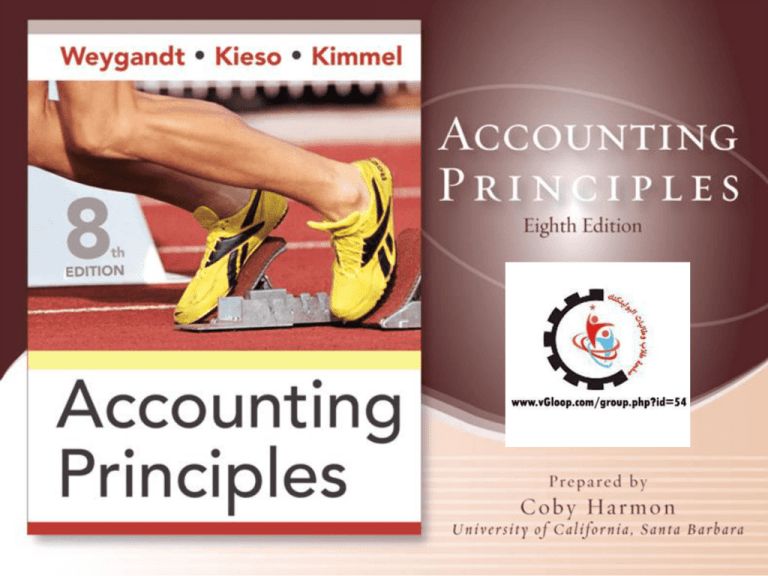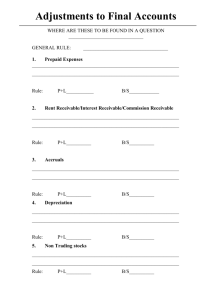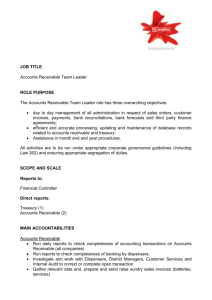
Chapter
9-1
CHAPTER 9
ACCOUNTING FOR
RECEIVABLES
Accounting Principles, Eighth Edition
Chapter
9-2
Study Objectives
1.
Identify the different types of receivables.
2.
Explain how companies recognize accounts receivable.
3.
Distinguish between the methods and bases companies use
to value accounts receivable.
4.
Describe the entries to record the disposition of accounts
receivable.
5.
Compute the maturity date of and interest on notes
receivable.
6.
Explain how companies recognize notes receivable.
7.
Describe how companies value notes receivable.
8.
Describe the entries to record the disposition of notes
receivable.
9.
Explain the statement presentation and analysis of
receivables.
Chapter
9-3
Accounting for Receivables
Types of
Receivables
Accounts
Receivable
Notes
Receivable
Accounts
receivable
Recognizing
accounts
receivable
Valuing
accounts
receivable
Disposing of
accounts
receivable
Determining
maturity date
Computing
interest
Recognizing
notes
receivable
Valuing notes
receivable
Disposing of
notes
receivable
Notes
receivable
Other
receivables
Chapter
9-4
Statement
Presentation
and Analysis
Presentation
Analysis
Types of Receivables
Amounts due from individuals and other companies that
are expected to be collected in cash.
Amounts owed by
customers that
result from the
sale of goods and
services.
Claims for which
formal
instruments of
credit are issued
as proof of debt.
“Nontrade”
(interest, loans to
officers, advances
to employees, and
income taxes
refundable).
Accounts
Receivable
Notes
Receivable
Other
Receivables
Chapter
9-5
LO 1 Identify the different types of receivables.
Accounts Receivable
Three accounting issues:
1. Recognizing accounts receivable.
2. Valuing accounts receivable.
3. Disposing of accounts receivable.
Recognizing Accounts Receivable
The following exercise was illustrated in Chapter 5.
For simplicity, inventory and cost of goods sold have
been omitted.
Chapter
9-6
LO 1 Identify the different types of receivables.
Recognizing Accounts Receivable
E5-5 Presented are transactions related to Wheeler Company.
1. On December 3,Wheeler Company sold $500,000 of
merchandise to Hashmi Co., terms 2/10, n/30, FOB shipping
point.
2. On December 8, Hashmi Co. was granted an allowance of
$27,000 for merchandise purchased on December 3.
3. On December 13,Wheeler Company received the balance
due from Hashmi Co.
Instructions: Prepare the journal entries to record these
transactions on the books of Wheeler Company using a
perpetual inventory system.
Chapter
9-7
LO 2 Explain how companies recognize accounts receivable.
Recognizing Accounts Receivable
E5-5 Prepare the journal entries for Wheeler Company .
1. On December 3, Wheeler Company sold $500,000 of
merchandise to Hashmi Co., terms 2/10, n/30, FOB
shipping point.
Dec. 3
Chapter
9-8
Accounts receivable
Sales
500,000
500,000
LO 2 Explain how companies recognize accounts receivable.
Recognizing Accounts Receivable
E5-5 Prepare the journal entries for Wheeler Company.
2. On December 8, Hashmi Co. was granted an
allowance of $27,000 for merchandise purchased
on December 3.
Dec. 8 Sales returns and allowances
Accounts receivable
Chapter
9-9
27,000
27,000
LO 2 Explain how companies recognize accounts receivable.
Recognizing Accounts Receivable
E5-5 Prepare the journal entries for Wheeler Company .
3. On December 13, Wheeler Company received the
balance due from Hashmi Co.
463,540 ***
Dec. 13 Cash
Sales discounts
Accounts receivable
*
9,460 **
473,000 *
($500,000 – $27,000)
** [($500,000 – $27,000) X 2%]
*** ($473,000 – $9,460)
Chapter
9-10
LO 2 Explain how companies recognize accounts receivable.
Accounts Receivable
Valuing Accounts Receivables
Are reported as a current asset on the balance
sheet.
Are reported at the amount the company thinks
they will be able to collect.
Sales on account raise the possibility of accounts
not being collected.
Valuation can be difficult because an unknown
amount of receivables will become uncollectible.
Chapter
9-11
LO 3 Distinguish between the methods and bases
companies use to value accounts receivable.
Valuing Accounts Receivable
Methods of Accounting for Uncollectible Accounts
Direct Write-Off
Theoretically undesirable:
no matching.
receivable not stated at
net realizable value.
not acceptable for
financial reporting.
Chapter
9-12
Allowance Method
Losses are estimated:
better matching.
receivable stated at net
realizable value.
required by GAAP.
LO 3 Distinguish between the methods and bases
companies use to value accounts receivable.
Presentation of Accounts Receivable
Assets
Current Assets:
Cash
Accounts receivable
Less: Allowance for doubtful accounts
Merchandise inventory
Prepaid expenses
Total current assets
Chapter
9-13
$ 346
500
25
475
812
40
1,673
LO 3 Distinguish between the methods and bases
companies use to value accounts receivable.
Presentation of Accounts Receivable
Assets
Current Assets:
Cash
Accounts receivable, net of $25 allowance
for doubtful accounts
Merchandise inventory
Prepaid expenses
Total current assets
Chapter
9-14
$ 346
475
812
40
1,673
LO 3 Distinguish between the methods and bases
companies use to value accounts receivable.
Valuing Accounts Receivable
Allowance Method for Uncollectible Accounts
1. Companies estimate uncollectible accounts
receivable.
2. To record estimated uncollectibles, companies
debit Bad Debts Expense and credit Allowance for
Doubtful Accounts (a contra-asset account).
3. When companies write off specific uncollectible
accounts, they debit Allowance for Doubtful
Accounts and credit Accounts Receivable.
Chapter
9-15
LO 3 Distinguish between the methods and bases
companies use to value accounts receivable.
Valuing Accounts Receivable
E9-6 On December 31, 2008, Jarnigan Co. estimated
that 2% of its net sales of $400,000 will become
uncollectible. The company recorded this amount as an
addition to Allowance for Doubtful Accounts. On May 11,
2009, Jarnigan Co. determined that Terry Frye’s account
was uncollectible and wrote off $1,100. On June 12, 2009,
Frye paid the amount previously written off.
Instructions
Prepare the journal entries on December 31, 2008, May
11, 2009, and June 12, 2009.
Chapter
9-16
LO 3 Distinguish between the methods and bases
companies use to value accounts receivable.
Valuing Accounts Receivable
E9-6 Prepare the journal entries on December 31, 2008,
May 11, 2009, and June 12, 2009.
December 31
($400,000 x 2% = 8,000)
Bad debt expense
8,000
Allowance for doubtful accounts
Chapter
9-17
8,000
LO 3 Distinguish between the methods and bases
companies use to value accounts receivable.
Valuing Accounts Receivable
E9-6 Prepare the journal entries on December 31, 2008,
May 11, 2009, and June 12, 2009.
May 11 (write-off)
Allowance for doubtful accounts
Accounts receivable
1,100
June 12 (recovery)
Accounts receivable
Allowance for doubtful accounts
1,100
Cash
Accounts receivable
Chapter
9-18
1,100
1,100
1,100
1,100
LO 3 Distinguish between the methods and bases
companies use to value accounts receivable.
Valuing Accounts Receivable
Bases Used for Allowance Method
Chapter
9-19
Illustration 9-5
LO 3 Distinguish between the methods and bases
companies use to value accounts receivable.
Valuing Accounts Receivable
Example Data
Credit sales
$500,000
Estimated % of credit sales uncollectible
Accounts receivable balance
1.25%
$72,500
Estimated % of A/R not collected
8%
Unadjusted balance in Allowance for Doubtful
Accounts:
Chapter
9-20
Case 1
$150 (credit balance)
Case 2
$150 (debit balance)
LO 3 Distinguish between the methods and bases
companies use to value accounts receivable.
Valuing Accounts Receivable
Percentage of Sales – disregards the existing
balance in Allowance for Doubtful Accounts
Credit sales
$500,000
Estimated percentage uncollectible
Estimated bad debt expense
1.25%
$
6,250
Journal entry:
Bad debt expense
6,250
Allowance for doubtful accounts
Chapter
9-21
6,250
LO 3 Distinguish between the methods and bases
companies use to value accounts receivable.
Valuing Accounts Receivable
Percentage of Sales
Case 1
Case 2
Actual balance (credit)
(150)
150
Estimated uncollectible
(6,250)
(6,250)
Ending balance
(6,400)
(6,100)
The Allowance for Doubtful Accounts has an ending
balance of $6,400 in Case 1 and $6,100 in Case 2.
Chapter
9-22
LO 3 Distinguish between the methods and bases
companies use to value accounts receivable.
Valuing Accounts Receivable
Percentage of Receivables
Accounts receivable
$ 72,500
Estimated percentage uncollectible
x
8%
Required balance in allowance account
$
5,800
===================================================
What will be the amount of the adjusting entry?
Chapter
9-23
LO 3 Distinguish between the methods and bases
companies use to value accounts receivable.
Valuing Accounts Receivable
Percentage of Receivables
Actual balance (credit)
Case 1
Case 2
(150)
150
Desired balance
(5,800)
(5,800)
Adjustment
(5,650)
(5,950)
Journal entry – Case 1:
Bad debt expense
5,650
Allowance for doubtful accounts
Chapter
9-24
5,650
LO 3 Distinguish between the methods and bases
companies use to value accounts receivable.
Valuing Accounts Receivable
Percentage of Receivables
Actual balance (credit)
Case 1
Case 2
(150)
150
Desired balance
(5,800)
(5,800)
Adjustment
(5,650)
(5,950)
Journal entry – Case 2:
Bad debt expense
5,950
Allowance for doubtful accounts
Chapter
9-25
5,950
LO 3 Distinguish between the methods and bases
companies use to value accounts receivable.
Valuing Accounts Receivable
When estimating losses using Percentage of
Receivables, companies often prepare an aging
schedule, which classifies customer balances by the
length of time they have been unpaid.
Illustration 9-7
Chapter
9-26
LO 3 Distinguish between the methods and bases
companies use to value accounts receivable.
Valuing Accounts Receivable
Summary
Percentage of Sales approach:
Focus on “Bad debt expense” estimate, any balance in
the allowance account is ignored.
Method achieves a matching of cost and revenues.
Percentage of Receivables approach:
Accurate valuation of receivables on the balance sheet.
Method may also be applied using an aging schedule.
Chapter
9-27
LO 3 Distinguish between the methods and bases
companies use to value accounts receivable.
Disposing of Accounts Receivable
Companies sell receivables for two major
reasons.
1. Receivables may be the only reasonable source
of cash.
2. Billing and collection are often time-consuming
and costly.
Chapter
9-28
LO 4 Describe the entries to record the disposition of accounts receivable.
Disposing of Accounts Receivable
Sale of Receivables
A factor buys receivables from businesses and then
collects the payments directly from the customers.
Typically the factor charges a commission to the
company that is selling the receivables.
The fee ranges from 1-3% of the amount of
receivables purchased.
Chapter
9-29
LO 4 Describe the entries to record the disposition of accounts receivable.
Disposing of Accounts Receivable
E9-7 (a) On March 3, Cornwell Appliances sells
$680,000 of its receivables to Marsh Factors Inc. Marsh
Factors assesses a finance charge of 3% of the amount of
receivables sold. Prepare the entry on Cornwell
Appliances’ books to record the sale of the receivables.
($680,000 x 3% = $20,400)
Cash
Service charge expense
Accounts receivable
Chapter
9-30
659,600
20,400
680,000
LO 4 Describe the entries to record the disposition of accounts receivable.
Disposing of Accounts Receivable
Credit Card Sales
Retailer considers credit card sales the same as
cash sales.
Retailer must pay card issuer a fee of 2 to
4% for processing the transactions.
Retailer records the sale in a similar manner
as checks deposited from cash sale.
Chapter
9-31
LO 4 Describe the entries to record the disposition of accounts receivable.
Disposing of Accounts Receivable
E9-7 (b) On May 10, Dale Company sold merchandise for
$3,500 and accepted the customer’s America Bank
MasterCard. America Bank charges a 4% service charge
for credit card sales. Prepare the entry on Dale
Company’s books to record the sale of merchandise.
($3,500 x 4% = $140)
Cash
Service charge expense
Sales
Chapter
9-32
3,360
140
3,500
LO 4 Describe the entries to record the disposition of accounts receivable.
Notes Receivable
Companies may grant credit in exchange for a
promissory note. A promissory note is a written
promise to pay a specified amount of money on
demand or at a definite time.
Promissory notes may be used:
1. when individuals and companies lend or
borrow money,
2. when amount of transaction and credit
period exceed normal limits, or
3. in settlement of accounts receivable.
Chapter
9-33
LO 5 Compute the maturity date of and interest on notes receivable.
Notes Receivable
To the Payee, the promissory note is a note receivable.
To the Maker, the promissory note is a note payable.
Illustration 9-10
Chapter
9-34
LO 5 Compute the maturity date of and interest on notes receivable.
Notes Receivable
Determining the Maturity Date
Note expressed in terms of
Months
Days
Computing Interest
Chapter
9-35
Illustration 9-13
LO 5 Compute the maturity date of and interest on notes receivable.
Recognizing Notes Receivable
E9-10 Orosco Supply Co. has the following transactions
related to notes receivable during the last 2 months of 2008.
Nov. 1 Loaned $15,000 cash to Sally Givens on a 1-year, 10%
note.
Dec. 11 Sold goods to John Countryman, Inc., receiving a
$6,750, 90-day, 8% note.
Dec. 16 Received a $4,000, 6-month, 9% note in exchange for
Bob Reber’s outstanding accounts receivable.
Dec. 31 Accrued interest revenue on all notes receivable.
Instructions
(a) Journalize the transactions for Orosco Supply Co.
Chapter
9-36
LO 6 Explain how companies recognize notes receivable.
Recognizing Notes Receivable
E9-10 Nov. 1 Loaned $15,000 cash to Sally Givens on a
1-year, 10% note. Dec. 11 Sold goods to John Countryman,
Inc., receiving a $6,750, 90-day, 8% note. Dec. 16
Received a $4,000, 6-month, 9% note in exchange for Bob
Reber’s outstanding accounts receivable.
Nov. 1
Notes receivable
Cash
Dec. 11 Notes receivable
15,000
15,000
6,750
Sales
Dec. 16 Notes receivable
Accounts receivable
Chapter
9-37
6,750
4,000
4,000
LO 6 Explain how companies recognize notes receivable.
Recognizing Notes Receivable
E9-10 Dec. 31 Accrued interest revenue on all notes
receivable.
Givens note:
Countryman note:
Reber note:
Amount
$ 15,000
6,750
4,000
Rate
x 10% x
x 8% x
x 9% x
Time
60 / 360 =
20 / 360 =
15 / 360 =
Total accrued interest
Dec. 31 Interest receivable
Interest revenue
Chapter
9-38
$ 250
30
15
$ 295
295
295
LO 6 Explain how companies recognize notes receivable.
Notes Receivable
Valuing Notes Receivable
Like accounts receivable, companies report shortterm notes receivable at their cash (net)
realizable value.
Estimation of cash realizable value and bad debts
expense are done similarly to accounts receivable.
Allowance for Doubtful Accounts is used.
Chapter
9-39
LO 7 Describe how companies value notes receivable.
Notes Receivable
Disposing of Notes Receivable
1. Notes may be held to their maturity date.
2. Maker may default and payee must make an
adjustment to the account.
3. Holder speeds up conversion to cash by selling
the note receivable.
Chapter
9-40
LO 8 Describe the entries to record the disposition of notes receivable.
Notes Receivable
Disposing of Notes Receivable
Honor of Notes Receivable
A note is honored when its maker pays it in full
at its maturity date.
Dishonor of Notes Receivable
A dishonored note is not paid in full at maturity.
A dishonored note receivable is no longer
negotiable.
Chapter
9-41
LO 8 Describe the entries to record the disposition of notes receivable.
Notes Receivable
E9-13 On May 2, Kleinsorge Company lends $7,600 to
Everhart, Inc., issuing a 6-month, 9% note. At the maturity
date, November 2, Everhart indicates that it cannot pay.
Instructions
(a) Prepare the entry to record the issuance of the note.
(b) Prepare the entry to record the dishonor of the note,
assuming that Kleinsorge Company expects collection will
occur.
(c) Prepare the entry to record the dishonor of the note,
assuming that Kleinsorge Company does not expect
collection in the future.
Chapter
9-42
LO 8 Describe the entries to record the disposition of notes receivable.
Notes Receivable
E9-13 (a) Prepare the entry to record the issuance of
the note. (b) Prepare the entry to record the dishonor of
the note, assuming that Kleinsorge Company expects
collection will occur.
(a)
Notes receivable
7,600
Cash
(b)
Interest = $7,600 x 9% x 6/12 = $342
Accounts receivable
Chapter
9-43
7,600
7,942
Notes receivable
7,600
Interest revenue
342
LO 8 Describe the entries to record the disposition of notes receivable.
Notes Receivable
E9-13 (c) Prepare the entry to record the dishonor of
the note, assuming that Kleinsorge Company does not
expect collection in the future.
(c)
Allowance for doubtful accounts
Notes receivable
7,600
7,600
When there is no hope of collection, the note holder would
write off the face value of the note. No interest revenue
would be recorded because collection will not occur.
Chapter
9-44
LO 8 Describe the entries to record the disposition of notes receivable.
Statement Presentation and Analysis
Presentation
Identify in the balance sheet or in the notes,
each major type of receivable.
B/S
Report short-term receivables as current assets.
Report both gross amount of receivables and
allowance for doubtful account.
I/S
Chapter
9-45
Report bad debts expense and service charge
expense as selling expenses.
Report interest revenue under “Other revenues
and gains.”
LO 9 Explain the statement presentation and analysis of receivables.
Statement Presentation and Analysis
Analysis of Receivables
Illustration 9-15
This Ratio used to:
Assess the liquidity of the receivables.
Measure the number of times, on average, a company
collects receivables during the period.
Chapter
9-46
LO 9 Explain the statement presentation and analysis of receivables.
Statement Presentation and Analysis
Analysis of Receivables
Illustration 9-16
Variant of the accounts receivable turnover ratio is
average collection period in terms of days.
Used to assess effectiveness of credit and collection
policies.
Collection period should not exceed credit term period.
Chapter
9-47
LO 9 Explain the statement presentation and analysis of receivables.
Copyright
“Copyright © 2008 John Wiley & Sons, Inc. All rights reserved.
Reproduction or translation of this work beyond that permitted
in Section 117 of the 1976 United States Copyright Act without
the express written permission of the copyright owner is
unlawful. Request for further information should be addressed
to the Permissions Department, John Wiley & Sons, Inc. The
purchaser may make back-up copies for his/her own use only
and not for distribution or resale. The Publisher assumes no
responsibility for errors, omissions, or damages, caused by the
use of these programs or from the use of the information
contained herein.”
Chapter
9-48






